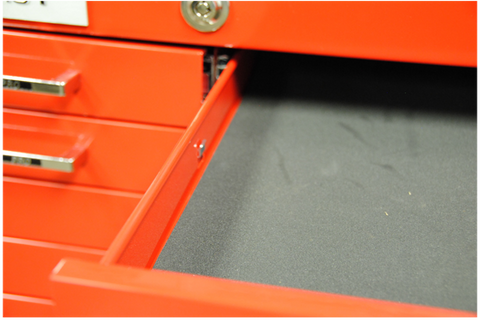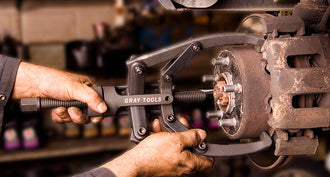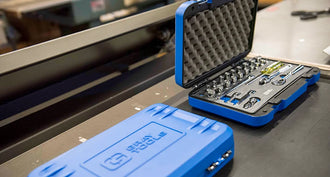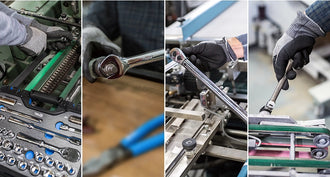Shopping For a New Tool Chest? Here Is What You Need To Know (Part 2: The Drawer System)
- Gray Tools Official Blog
- 15 Mar, 2017

In part 1 in our series, we defined user needs and expectations, and focused on frame construction.
In part 2, we will focus on the drawer system; its key elements and how it impacts the toolbox functionality and durability.
The main and obvious function of the drawer system is to store tools safely, while allowing easy and secure access to its contents.
Drawers (including the slides) are generally the most expensive part in the overall cost of manufacturing a toolbox. Not only is each drawer a separate production process, but each one requires at least one pair of slides.
As a rule of thumb, the greater the number of drawers the higher the price of the toolbox. Keep in mind that cost is not the only true indicator of quality.
On that note, let us examine quality and production differences in greater depth.
Drawer Construction
Although drawers can come in many different widths, depths, and heights, some characteristics are universal signs of a superior quality:
- The gauge of steel used in their construction is critical. The typical gauge of steel used falls into the 18-22G range. The lower the number the thicker and more durable the steel. A drawer made of 18G steel is more durable than one made of 20G steel.
- A simple yet obvious indication of quality construction is the drawer edges. Inferior quality roller cabinets will have drawers whose edges (sides running from front to back) are simply straight. On premium quality boxes, these sides will be rolled or folded over creating a rounded top edge. In addition to a safer duller edge the rolled over edge provides significant drawer stiffness. This extra stiffness is very important for heavily loaded drawers. The added strength prevents drawer deformation. This extra rigidity can easily be seen by twisting a straight edge vs rolled over drawer.

- Many roller cabinets today include some form of drawer liner kit. Fortunately simply removing the liners can reveal another sure-fire quality indicator. A drawer with a stamped bottom is a positive sign of superior workmanship and attention to detail. The reason for this is, stamping a drawer bottom acts like "corrugation", which provides tremendous increase in strength and durability. This is extremely beneficial for users who heavily load their boxes and move their cabinets around frequently.
- Although not specifically a quality consideration, drawer design is an important factor. Drawers with a flush front design (drawer fronts are even with the surrounding frame) utilize space more efficiently. Losing a ¼" to ½" over as many as 15 drawers came result in a significant loss in storage space. Before buying, measure to confirm the roller cabinet's actual cubic/inch storage capacity.
Apart from construction, pay close attention to your current and future storage needs.
Roller cabinets with many shallow drawers are ideal for holding flat tools such as pliers, wrenches, micrometers and other hand tools.
If your tool collection includes larger bulkier items such as welding helmets, power tools and deep sockets consider a box with deeper drawers. As a general guideline always purchase a roller cabinet with as many drawers as you can afford. This prevents your tool collection from looking like your child's chaotic toy chest.
Manufacturers often ignore drawer construction details in favor of stating specs on slides. The most commonly communicated specification is the maximum load capacity.
However, like all other elements in a tool chest, it is important to look beyond the numbers as not all components are created equal.
Drawer Slides

Slides can generally be categorized into two types: friction and bearing.
Friction or non-roller bearing slides work like just like roller bearing slides. They require insertion of the female glides (on sides of drawer) into the male channels (located inside the cabinet).
As the name implies the slides do not have bearings and therefore open and close using purely kinetic friction. The steel on steel contact results in a difficult (greater force required by user), noisier, and slower drawer movement.
Although unsophisticated in their design, friction slides provide numerous benefits and advantages:
- Friction slides are cheaper than roller bearing slides. This explains why they are most commonly found on entry-level tool chests with lower price points
- By eliminating any extra components, friction slides are extremely robust with no weak points to cause failure
- Outside of accidental bending friction slides will almost never need to be replaced
- Apart from occasional lubrication (not grease) friction slides require no maintenance or upkeep
- Non-ball bearing slides are ideal in work environments were the possible failure of a ball bearing is not permissible
- Their ease of removal and re-installation makes misalignment during re-assembly almost impossible
Bearing slides work in the same manner as friction slides except their design incorporates ball or roller bearings. The use of bearings provides a smooth surface on which the male and female glides will move along.
The result is a virtually effortless, quiet, and faster drawer opening experience. Bearing slides are the mostly common type of slide used today.
As bearing slides have become commonplace it is important to differentiate the great from the average:
|
Maximum Load Capacity: |
· The most commonly communicated feature by manufacturers · Premium roller cabinets will have capacities 100lbs or greater · The higher the number the greater the load the drawer can handle |
|
Amount of Extension: |
· Not all slides are designed to extend all the way. This means a drawer with a 75% extension will always leave 25% of the contents inside the cabinet. This makes finding and retrieving your tools more difficult and inconvenient. Look for models with full extension slides. |
|
Cycle Tests: |
· Understandably manufacturers seldom indicate this fact, however before you spend your hard-earned money ask how many cycles the slides have been tested to. A quality slide will have test cycles in excess of 20,000. |
|
Serviceability: |
· Having the added complexity of the ball bearings means things may break. If you are going to invest in quality it is worth exploring the manufacturer's policy on repair parts. It’s a shame to have to replace an entire toolbox due to a damaged slide(s) or drawer(s) |
|
Number of Slides Per Drawer: |
· Premium roller cabinets will have double slides (4 instead of 2) on deep drawers. This allows drawers to hold more weight while lessening the likelihood of damage due to overload · High-end roller cabinets also feature additional under mounted slide(s) on extra wide drawers (50" wider). This extra allows the drawer to hold more weight, while preventing drawer sag in the middle section of the drawer |
In summary, it is important to choose a roller cabinet with quality drawers and slides since you will be opening and closing them many times daily. It is also equally important to consider the size and makeup of your tool collection and understand your expectations.
If you open your drawer frequently and expect to heavily load the drawers, a roller cabinet with a mix of shallow and deep drawers equipped with heavy-duty, high capacity slides is an ideal choice.
If your tool collection is small, a box with few drawers and friction slides could be the budget friendly choice for you.
In future posts in this series we will look at other key components such casters and the locking mechanism.





Excellent information, I thank you. I’m building a wooden tool chest and wonder where you’d recommend buying 16" ball bearing slides for it’s drawers? Thanks again.
Is it possible to change my 11 drawer pro series friction slide to a roller slide? I can’t find replacement friction slides for my tool box .